How To Choose Keywords For SEO: A Beginner’s Guide

Keywords are an indispensable part of SEO because an SEO strategy or campaign’s success significantly depends on them. You must choose the right keywords to achieve desired results and success for your page or site. The right keywords will make your content effective enough to attract excellent organic search traffic over time.
However, you must know the basics before learning to choose keywords for SEO campaigns. Here is everything you need to know about keywords, keyword research, and their importance.
Table of Contents
- What Are Keywords?
- Understand Types of keywords:
- Understand Types of keywords:
- Short-tail Keywords
- Intent Targeting Keywords
- Intent Targeting Keywords
- Latent Semantic Indexing Keywords
- How To Do Keyword Research For SEO?
- Why is Keyword Research Important?
- How To Check Keyword Ranking?
- How To Check Keyword Ranking?
- Final Thoughts
What Are Keywords?
Keywords in terms of SEO are words or phrases searchers use to find information on a specific topic through the search engine. A single word or a long phrase is considered a keyword if searchers widely use it on a search engine. They are also known as key phrases, SEO keywords, or search queries.
Keywords are crucial in SEO because they are the key player to bridge between your content and information and what users are searching for. They are used in content to drive organic traffic from search engine result pages. Therefore, the type of traffic your website or content gets totally depends on the keywords you choose.

Understand Types of keywords:
Keywords are typically classified into four types. They may be classified on the basis of phrase length, intent, and other factors:
1. Short-Tail Keywords
Keywords with just 1-3 terms are known as Short-tail keywords. They have a wider search intent, high search volume, higher competitive rate, and low conversion rates. You can use them with your page’s title or as part of your text. Additionally, they can be used as a core keyword that constantly occurs throughout your website.
Short-tail Keyword example:
- Real estate
- SEO company
- WordPress themes
- Electric cars
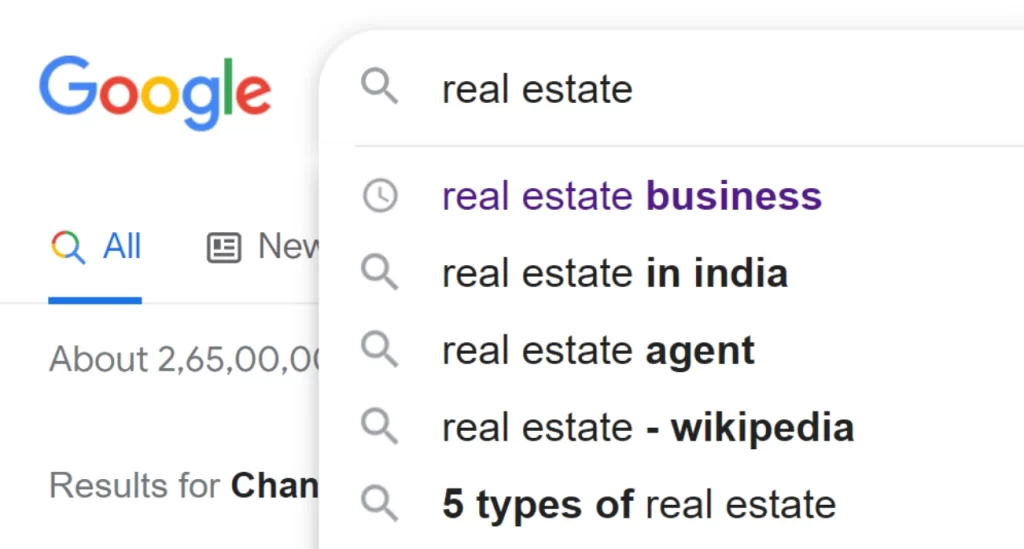
2. Long-Tail Keywords
Keywords with a word count of four or higher are referred to as long-tail keywords. They might even be a complete sentence or question. Typically, these are far more explicit (specific) compared to short-tail keywords.
They have a particular search purpose, low search volume, less search engine competition, and a higher conversion rate. You can use them for specially targeted pages such as blog posts or product pages.
Long-tail keyword examples:
- Best SEO Interview Questions
- Best running shoes for winter
- Top link building strategies
- Best SEO techniques for local business

3. Intent Targeting Keywords
The keywords that define users’ intent for making searches are known and intent-targeting. They are subcategorized into four types, informational, commercial, transactional, and navigational.
Intent targeting keywords –
- Informational: How to learn SEO?
- Navigational: Google Drive
- Transactional: Buy sport shoes
- Commercial: Best SEO services

4. Latent Semantic Indexing Keywords
The keywords closely connected to your primary keyword are called Latent Semantic Indexing (LSI). They can improve the main keyword’s ranking signal and benefit content generation. They have low search volume, less competition, high conversion rates, and precise search intent.
Latent Semantic keywords: (Primary keyword on the page – SEO Tools)
- SEO Tools
- SEO Tools Free
- SEO Tools For Websites
- SEO Tools For Keyword Research
Apart from these basic keyword types, there are some other types categorized on the basis of how and where they are used.
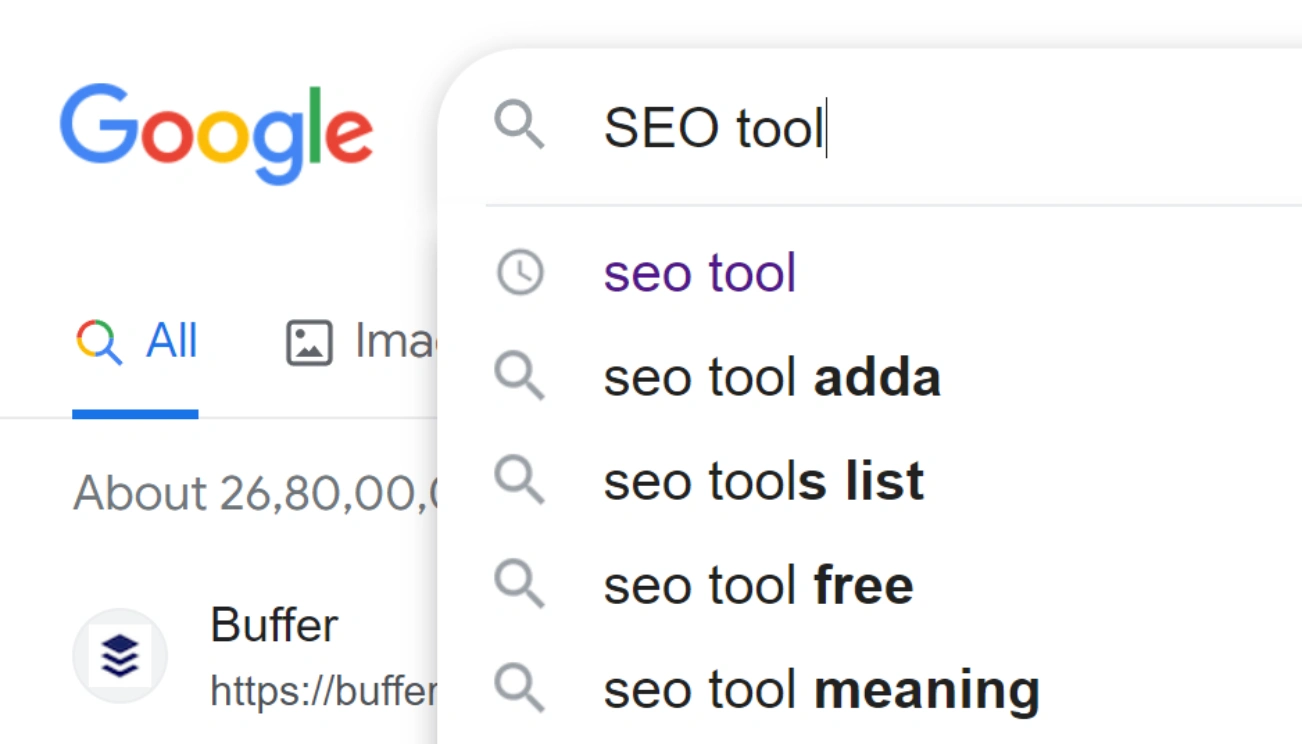
How To Do Keyword Research For SEO?
Keyword research refers to retrieving words, phrases, or user queries. It incorporates establishing a link between a keyword’s relevance to particular web pages or a website.
Here is a step-by-step process to perform keyword research:
Step 1: Prepare for Keyword Research and Find Keywords.
- Start by defining your goals: Determine the purpose of your keyword research. Are you looking to improve SEO, drive organic traffic, or specific audience segments?
- Understand your target audience: Identify the characteristics and preferences of your target audience. This will help you create a list of relevant keywords.
- Make a list of seed keywords: These are the initial keywords or phrases related to your business or industry. Brainstorm a comprehensive list of seed keywords relevant to your website or content. (A seed keyword is like a starting point when doing keyword research. You use a larger keyword related to your niche or topic to discover more specific keyword ideas. Think of it as a stepping stone that leads you to find additional keywords related to your main topic.)
- Get more keywords: Use a seed keyword and any keyword research tool for this. The tool will suggest more keywords related to the seed keyword you have used. It will provide you with a list of the most popular keywords.
For example, the seed keyword is “Dental Implants” You can get more related keywords using the Keyword Magic Tool by Semrush.
Step 1: Enter the seed keyword, select your target location, and click the “Search” button.

You will see around 377.3K keyword suggestions based on the seed keyword.

Step 2: To get a better overview of the most popular topics in your niche, categorize the keywords in topical groups and subgroups from the left column of the tools window.

It will help you identify which keywords are relevant to your topic and which are not.
Step 3: To get more specific subtopics and their keywords, drill down into each of these topical groups.
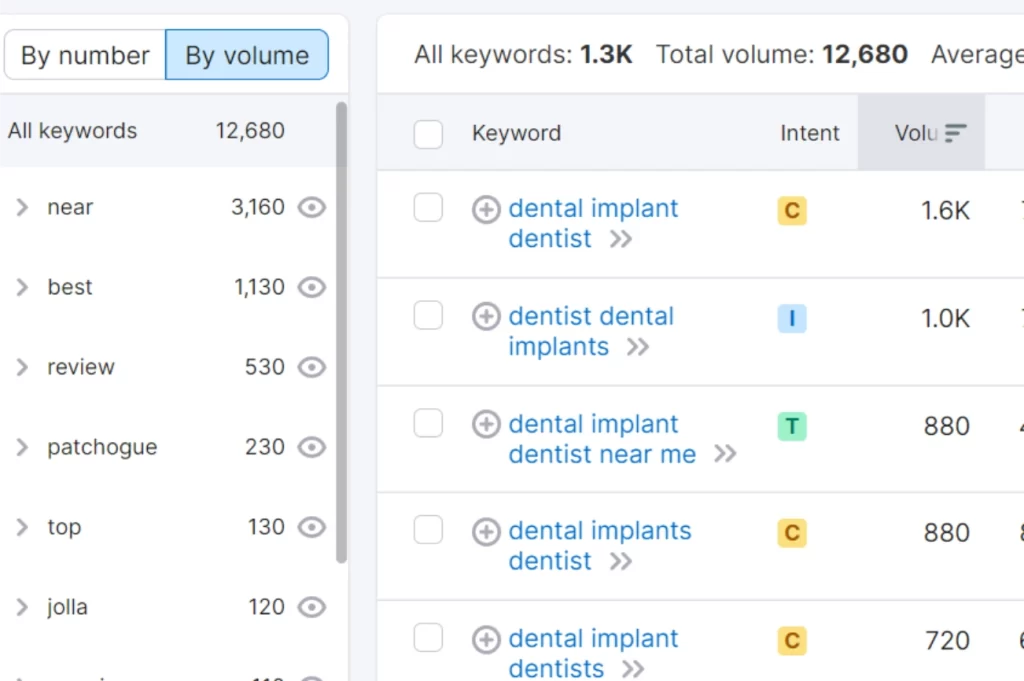
Form this, you can get an overview of the most relevant and used keywords.
- Analyze competitor keywords: Identify your competitors and analyze their target keywords. This can provide you with ideas for additional keywords to target..
For this, you can use competitive analysis tools. You only need to enter the competitor’s domain with the target location. You need to perform this for all your toughest competitors.
Step 1: Open Semrush’s Organic Research tool and enter your competitor’s domain.
Step 2: Now, choose the location and click “Search”.

In case you are unsure of your competitor’s domain, search your website’s domain and go to the “Competitors” tab, then choose “Position”.
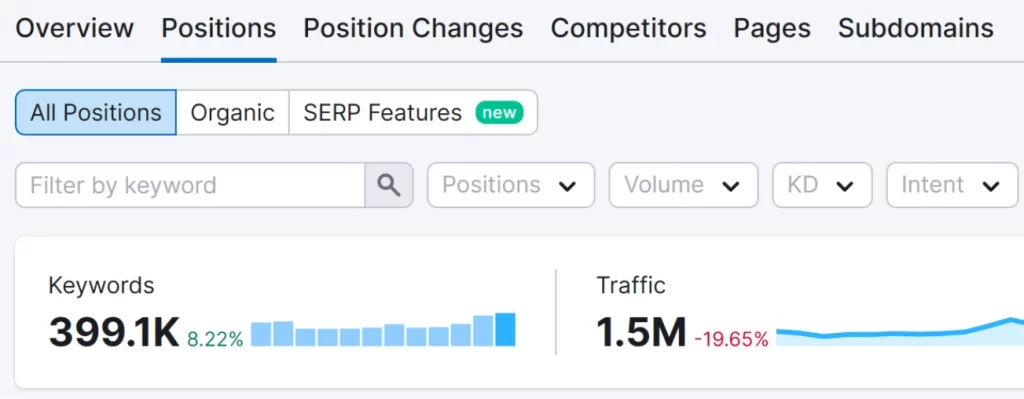
You will see your competitor’s keywords with all the details like traffic they bring, where they rank, etc.
Step 3: From here, filter out their brand keywords. Go to the window’s right >> Advanced filters” >>”Exclude ” >> “Keyword type” >> “Branded.”
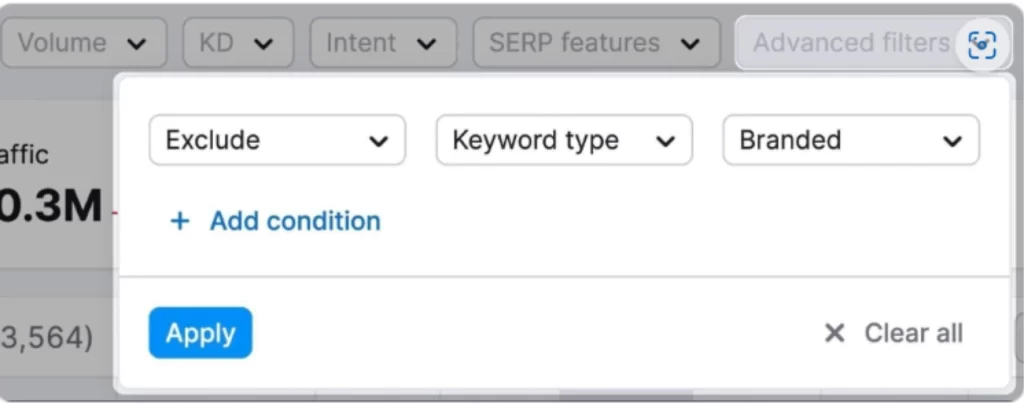
- Find Keywords you might have missed: If you already have a website that covers topics related to your industry or niche, you can enhance your competitor analysis for keyword research. It will help you find keywords for which you don’t rank, but your competitors do keywords for which your competitors rank higher.
You can use a tool like Keyword Gap to compare our keywords with your competitors.
Step 1: Open the tool, enter your and your competitor’s domains, choose the location, and click “Compare”.
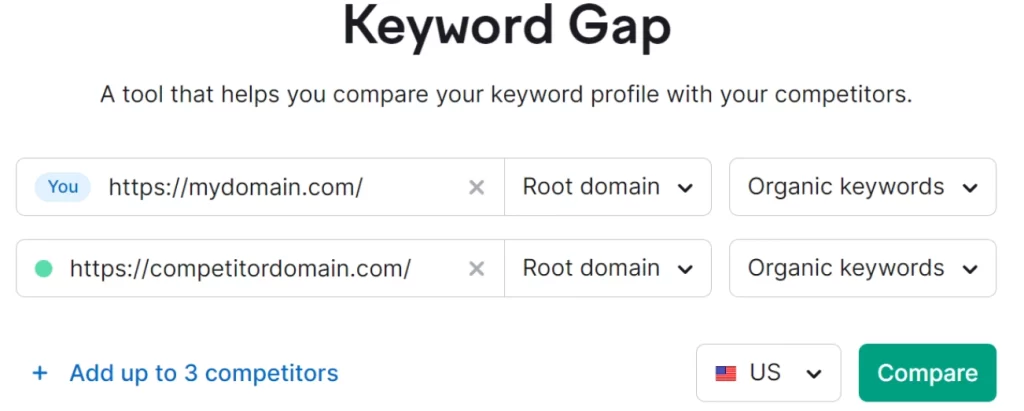
Step 2: Scroll down and find out “Missing” and “Weak” tab.

Here you may find some great keywords that your competitors consider and which are worth targeting.
Step 2: Refine and Prioritize Your Keyword List.
- Analyze keyword metrics: Use keyword research tools to evaluate the keywords’ search volume, difficulty, and competition level. This will help you identify keywords that are worth targeting.
Search volume reflects the popularity of the keywords. You can understand it as the number of times searches are made using certain keywords in a given period (usually monthly). If a website ranks for keywords with higher search volume, it can get more traffic.
For instance, if you use the Keyword Overview Tool by Semrush for the keyword “dental Implants,” you will see the following results.

Keyword difficulty is a measure that determines how difficult it is for a website or content to rank on the top of SERP for any keywords. Evaluating any keyword’s difficulty before using it in your content will let you know whether to invest time and money in it or not.
Implementing keyword competition into different digital marketing strategies involves various subtleties and considerations that depend on multiple factors, including how competitive a keyword is.
Regarding SEO, keyword difficulty is generally measured by the quality and number of backlinks the top ten pages of SERP have for a certain keyword.
Factors that are used to measure keyword difficulty-
- Competitors
- Content quality
- Search intent
- Backlinks
- Domain authority
In addition, the competitiveness of those pages is also calculated depending on the strength of their backlinks.
For instance, see the keyword difficulty of the keyword “SEO services” below.

So, the higher the keyword difficulty score, the more difficult it will be to rank for a certain keyword.
- Prioritize keywords: Based on your goals, select the keywords that align with your target audience, have sufficient search volume, and are achievable based on your website’s authority and competition level.
Step 3: Targeting Keywords
- Identify primary keywords: Though one topic can have multiple keywords, it still needs a primary keyword that targets it.
To identify a primary keyword, you can use Keyword Overview Tool as follows:
Step 1: Take “how to get free dental implants” for example.
Step 2: Open this in the Keyword Overview Tool.
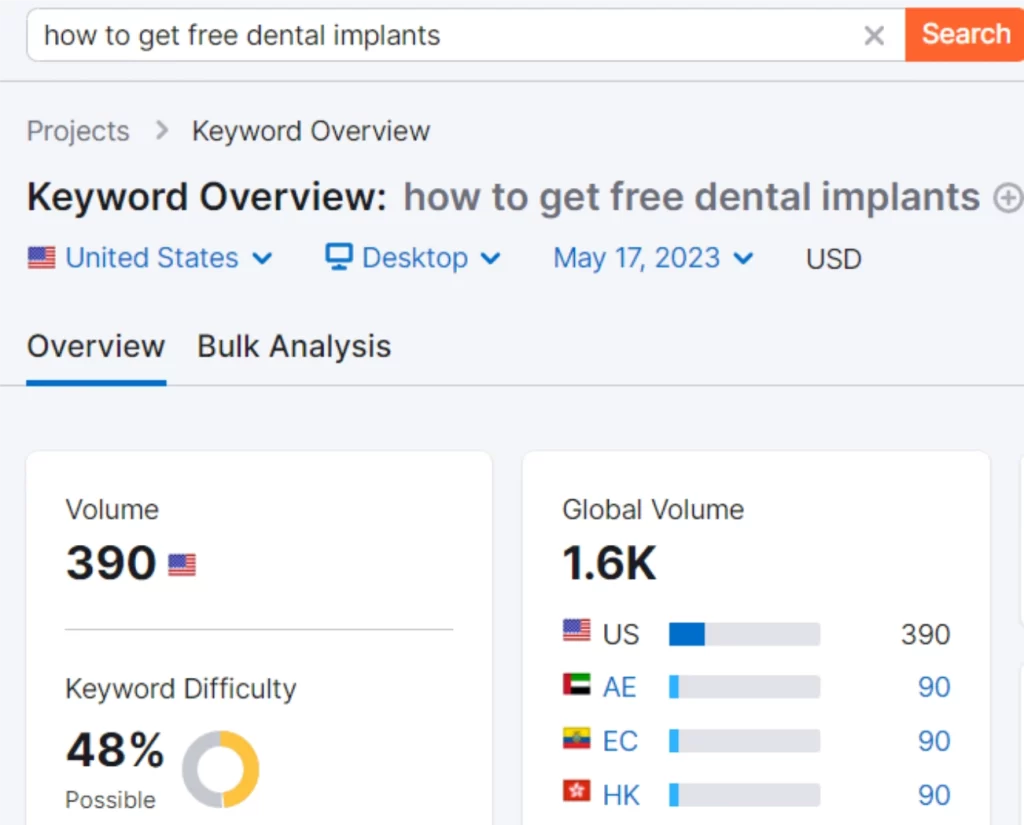
Step 3: Now, scroll down the window to find the “SERP Analysis” section.
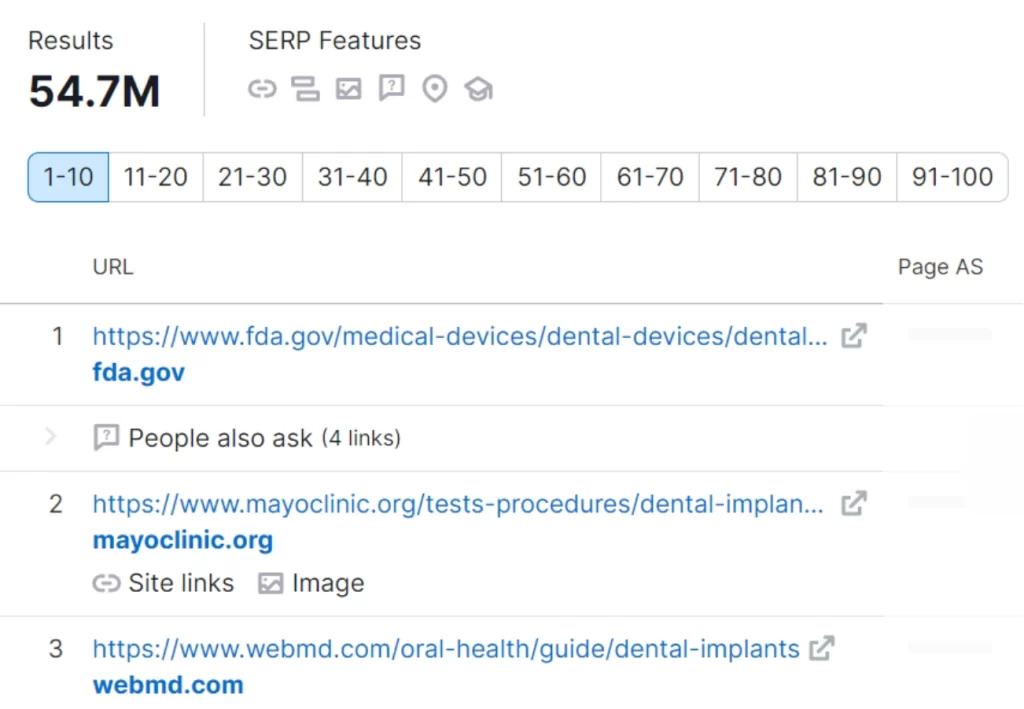
This analysis suggests that the selected keyword is not the good target keyword because it doesn’t show up in many results’ URLs.
Step 4: Now, use the Organic Research tool to check the first URL.
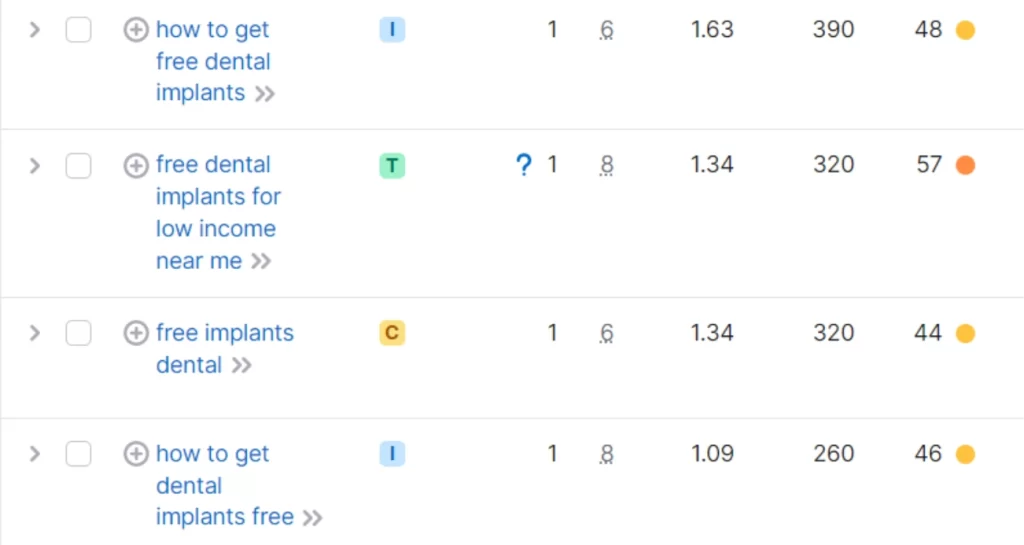
From here, we can conclude that the “how to get free dental implants” is the biggest keyword as it has the highest search volume and brings good traffic to the page. So, it will be a better primary keyword; not “how to get free dental implants”
- User intent: Understand the intent behind specific keywords. Are users looking for information, products, or solutions? Aligning your content with user intent helps improve the chances of engagement and conversions.
A users intent can be as follows:
You can use the Keyword Magic Tool to nail the search intent.
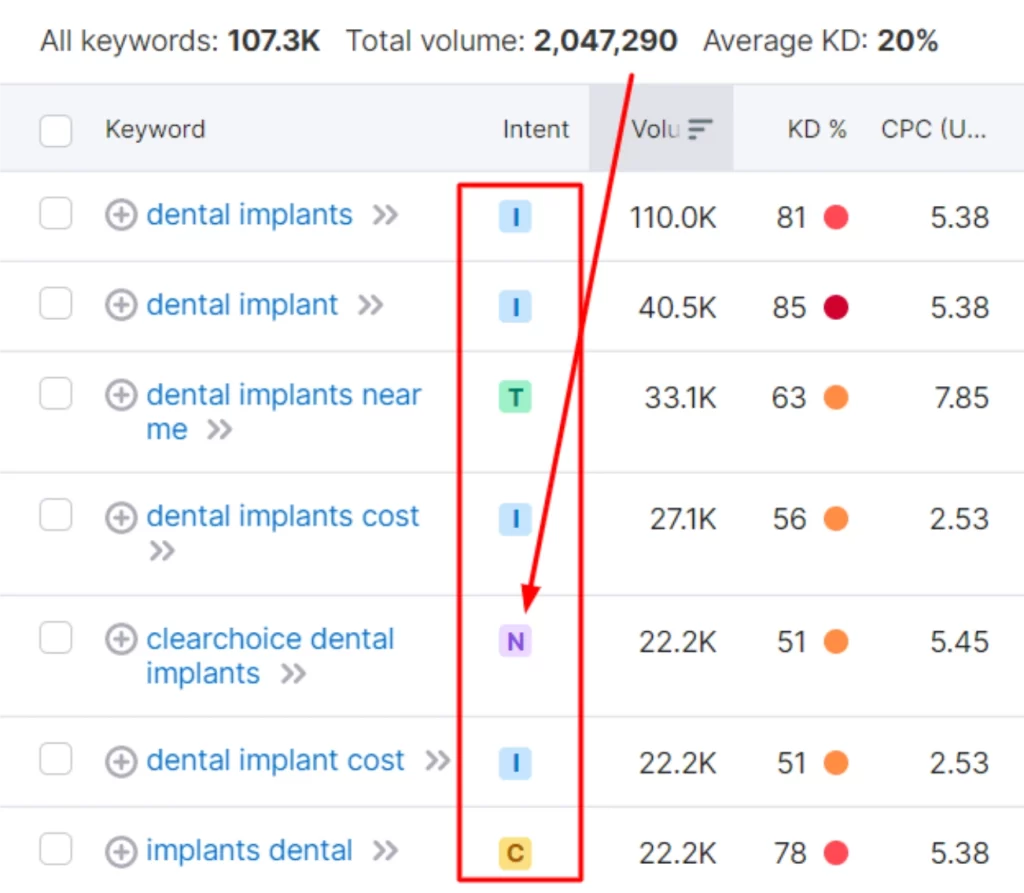
Remember, keyword research is an ongoing process. Regularly monitor your keyword performance, adapt to changes in search trends, and continue to refine and expand your keyword list to stay competitive and relevant.
Why is Keyword Research Important?
Keyword research is among the essential aspects of SEO. It helps determine what themes to write about and the phrases to use when writing, in addition to knowing how to create a decent keyword list.
Here are five reasons why keyword research is important:
- Keyword research helps to determine what users are searching on search engines.
- It will help you understand users’ search intent for a specific keyword.
- It helps understand the competitive landscape and provides precise insight into difficulties in ranking with particular keywords.
- You can find content prospects with low competition that will help you draw more visitors.
- It also assists you in engendering new ideas for developing content.
Whether it be a blog, an online store, or a local business offering services, a proper keyword research is quite beneficial.
How To Check Keyword Ranking?
Checking keyword rankings is essential for monitoring your website’s performance and SEO efforts. There are several methods you can use to check keyword rankings.
Let’s discuss some of the most common and effective ways in detail.
Manual Search –
The simplest method is manually searching for your target keyword on search engines like Google, Bing, or Yahoo. Open an incognito or private browsing window to avoid personalized search results.
Procedure –
Step 1: Open a web browser and go to a search engine like Google, Bing, or Yahoo. Open an incognito or private browsing window to avoid personalized search results.

Step 2: Enter your target keyword in the search bar.
Step 3: Scroll through the search engine results pages (SERPs) and look for your website’s position. Take note of the page and position where your website appears.
Step 4: Repeat the process periodically to track any changes in your website’s ranking for the keyword.
Google Search Console –
It is a free tool provided by Google that offers valuable insights into your website’s performance in search results. This approach provides a comprehensive overview of all the keywords for which your domain ranks.
Instead of the time-consuming process of manually searching for each keyword on Google, you gain access to a complete list of rankings in one place. It also provides data on each keyword’s average position, impressions, and clicks.
Procedure –
Step 1: Sign in to your Google Search Console account or create a new one if you don’t have an account.
Step 2: Add and verify your website property in Google Search Console by following the instructions.
Step 3: Navigate to the “Performance” section once your website is verified.
Step 4: Look for the “Search results” tab to view the keywords driving traffic to your website.
Step 5: Analyze the data to determine each keyword’s average position, impressions, and CTR.
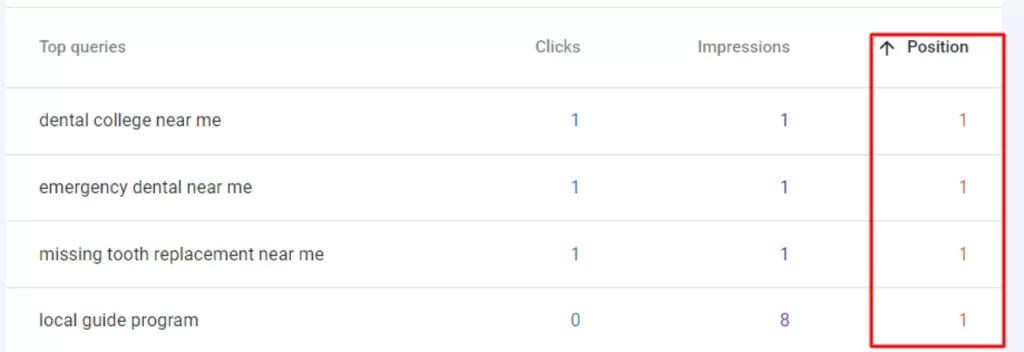
Rank Tracking Tools –
Numerous online tools are designed specifically for tracking keyword rankings. These tools automate the process and provide detailed reports on keyword positions. Some popular options include SEMrush, Moz, Ahrefs, and Serpstat. These tools often offer additional features like competitor analysis, keyword research, and backlink tracking.
Procedure –
Step 1: Choose a rank-tracking tool like SEMrush, Moz, Ahrefs, or Serpstat.
Step 2: Sign up for an account on the selected tool’s website.
Step 3: Enter your website’s URL and target keywords in the tool’s dashboard.
Step 4: Configure the settings, such as the search engine (e.g., Google) and location (if applicable).
Step 5: The tool will periodically query the search engine and retrieve your website’s position for each keyword.
Step 6: Access the reports generated by the tool, which typically show keyword rankings, historical data, and trends.
Web Analytics Tools –
If you have web analytics tools like Google Analytics set up on your website, you can extract valuable data regarding keyword rankings. Analyze the organic search traffic data to identify which keywords drive traffic to your website. Although these tools do not provide real-time keyword rankings, they offer insights into the overall performance of your keywords.
Procedure –
Step 1: Follow the instructions and set up a web analytics tool like Google Analytics on your website.
Step 2: Navigate to the organic search traffic section under the “Acquisition” or “Traffic” tab.
Step 3: Look for the keywords driving organic search traffic to your website.
Step 4: Analyze the data to identify the average position and the performance metrics associated with each keyword.
Mobile Ranking –
With the increasing popularity of mobile devices, it’s crucial to consider keyword rankings on mobile searches. Mobile optimization plays a significant role in SEO. Many rank tracking tools mentioned earlier provide separate mobile ranking reports.
Procedure –
Step 1: Use a rank tracking tool that provides separate reports for mobile rankings.
Step 2: Configure the tool to track mobile rankings specifically.
Step 3: Access the reports to see how your website ranks on mobile search results for each keyword.
Local Ranking –
If you have a local business, tracking local keyword rankings is essential. As mentioned above, tools like BrightLocal, Whitespark, or the local SEO feature within rank-tracking can help you monitor how your website ranks for location-based searches.
Procedure –
Step 1: Utilize tools specifically designed for tracking local keyword rankings, such as BrightLocal or Whitespark.
Step 2: Set up your location and target keywords within the tool.
Step 3: The tool will query the search engine and retrieve your website’s local ranking positions.
Step 4: Review the reports to monitor the performance of your website for local searches.
Remember to perform these steps periodically to track keyword rankings over time and make informed decisions regarding your SEO strategy.
Final Thoughts
Choosing the correct keywords for your website depends on your keyword strategy. Although selecting keywords for SEO isn’t difficult, you must think about the advantages to your brand and lead generation while keeping an eye on your competitors. Typically, you should prioritize consumers’ needs over keywords that increase traffic.
